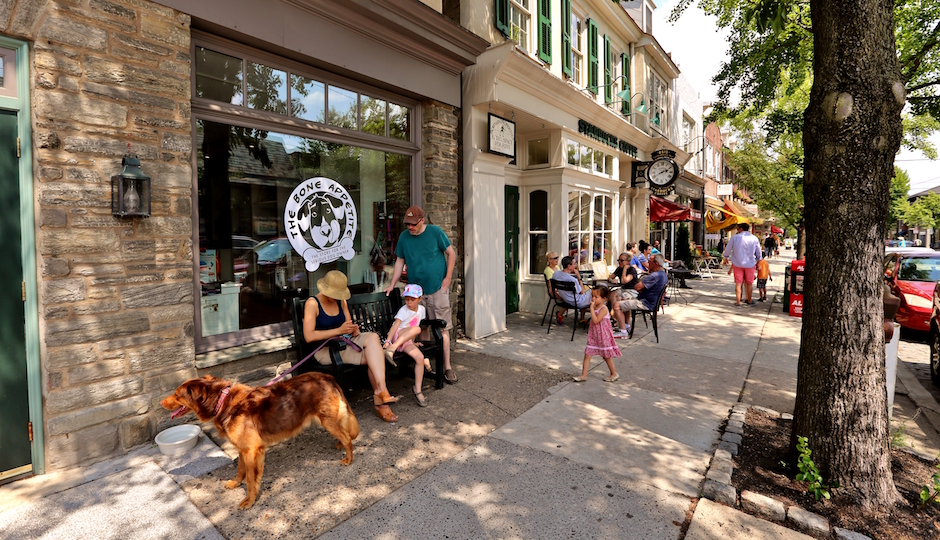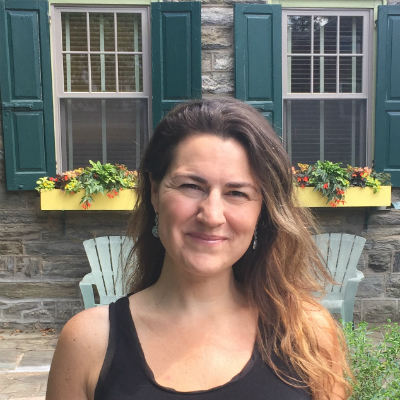Is Chestnut Hill the New East Passyunk?

Distinctive shops like Bone Appetite have led a new generation of fans of urban life to discover the joys of Chestnut Hill. The road to today began with the Starbucks right next door. | Photo courtesy Chestnut Hill Business Improvement District
It’s sometime after 5 on the Friday evening of Memorial Day weekend. That usually means Philly’s restaurants are quiet because everyone’s down the shore. But all the bar seats at Paris Bistro in Chestnut Hill are full. There are regulars, out-of-towners, and a large, boisterous group. From behind the bar, Justin Bellerjean presides over the scene genially. As the night goes on, he explains, the personality of this space will change. “Having a nice neighborhood corner bar … you see different layers of customers come in,” he says. “My Monday happy hour crowd, it’s like the men’s bar at a city club.”
My burger order hadn’t gone to the kitchen yet, but I wasn’t particularly worried that 15 minutes had passed since I placed it—it’s easy to get caught up in the vibe. Even chef/co-owner Al Paris seemed to be having fun.
This new, up-late Chestnut Hill isn’t the neighborhood I visited in the early 1980s. Back then, ads on the radio spoke in plum tones about the “little shops” along Germantown Avenue and the “Ladies Who Lunch” made up the crowd at the handful of restaurants. Now, three decades and two waves of change later, that crowd has mostly ceased to define the environment of Philadelphia’s most elevated business district. (Literally: the highest point in the city is just north of the Germantown Avenue commercial strip.) Far from being a prim and proper enclave for bluebloods, today’s Chestnut Hill has finally become the urban (and urbane) village it has long had the potential to be.
And really, it’s all because the timing was finally right.
The seeds of today’s Chestnut Hill were planted in 1909 by a man named Dr. George Woodward, who had been building handsome suburban homes for the well-to-do in the manner of his father-in-law, Henry Howard Houston. That year, in an effort at social reform, he started building more modest twins and innovative quads that he intended to offer to working families at the same ultra-low rents he offered the swells, but the swells snapped them up first, and Chestnut Hill’s reputation as a blueblood enclave became firmly entrenched. (Woodward would go on to build more than 400 houses, most of which two family companies still own, and while the rents are no longer super-low, they’re still reasonable by today’s standards.)
The shops on Germantown Avenue primarily catered to these residents. They were what you’d find on any Main Street: drugstores, hardware stores, small grocery stores, flower shops, lunch counters. Several of these businesses lasted for decades, and a few, like Killian’s Hardware and Robertson’s Florist, are still there today.
But the shopkeepers aged, and their children left, and the business district started to fade. “In the 1980s, the area was still vibrant but fraying in places,” said Richard Snowden, the head of Bowman Properties, which controls a good chunk of the commercial real estate along Germantown Avenue today. Snowden’s firm started buying up those properties in hopes of keeping them in local hands, but what would replace them was unclear: “For a while, it was a little touch and go. We didn’t know who would occupy these shops.”
Korin Korman, owner of the 3000BC spa, opened her store on what Chestnut Hillers call “The Avenue” around that time, in 1992. “I think the most notable shift was that there were some national retailers at that time,” she said. “There was a Gap, a Borders bookstore, The Children’s Place.”
And for a while, the Avenue survived off the traffic they brought. But chain retail has its own issues in our changing world, and many of them bailed in the early 2000s. The one chain that really resonated with the neighborhood—and the one Snowden says helped bring the Avenue back—was, ironically, Starbucks. When it opened in the mid-’90s, it was one of the first outlets in Philadelphia and gave people a meeting place near the center of town. It proved to be a steppingstone on the road to rejuvenation. “High-quality chains act as magnets,” he said, drawing in customers who then explore the more interesting local offerings.
The trouble was, there weren’t enough of those quality local offerings at the time Starbucks opened. The Chestnut Hill Business Association, the volunteer group that watched over the retail district, recognized something needed to be done.
As streets like 13th Street in Midtown Village and East Passyunk Avenue in South Philly have proven, a plan and vision are crucial. So, after years of informal efforts to attract local merchants, the association launched the Chestnut Hill Business Improvement District in 2004. The group hired a full-time recruiter to lure in distinctive local boutiques and restaurants that would create the ideal mix of businesses on Germantown Avenue and bring back some of its original life.
It worked. According to the CHBID, vacancy rates on the Avenue have been cut almost in half since 2009, from 13 percent to just over seven percent.
The new shops and restaurants are original and creative, and they make walking the upper reaches of Germantown Avenue feel like you’ve stumbled upon some adorable little Main Street in some small town in Upstate New York or New England. There’s a timeless feel to the place; as Korman put it, “it’s been 300 years in the making but it will always be this way.” But timing was also at play here: our society’s renewed love of walkable urban centers in sylvan suburban settings was really what made this all possible.
The crowd here feels younger and more diverse. And business owners are noticing. Hillary O’Carroll, the owner of Isabella Sparrow, a farmhouse-flavored interior design boutique, relocated her shop from Bryn Mawr to Chestnut Hill in 2014. (In fact, she says, she “moved mountains” to get the space she wanted. She was used to this, as she moved to Pennsylvania from the mountains of western North Carolina in 2006 after falling in love with a man who lured her here using Chestnut Hill as the bait.)
“Chestnut Hill is such a place apart,” she said, echoing a sentiment many others I spoke with for this story expressed. The community, she says, reminds her of the European villages she would visit almost every summer. And, she says, it turns out that villages like these represent an environmentally friendly way to live. “If you’re out in the country, you have to go all the way into town to get the things you need to live.” But in walkable communities like Chestnut Hill, the only time she needs to leave the village is to get things for her shop.
The easy access to public transportation and the quick trip to downtown are another selling point for today’s homebuyers. There are four SEPTA Regional Rail stations on two separate lines in the town, including one right on Germantown Avenue, as well as three bus routes that serve the neighborhood.

Karrie Gavin
That village character is something that appeals to new residents like Karrie Gavin, who moved there in the fall of 2014 after 12 years in Center City. An agent with Elfant Wissahickon Realtors, Gavin sells homes in both Chestnut Hill and Center City. Once she got married and had kids on the way, she started looking for a place where she could still enjoy urban vitality while giving her kids room to play. Chestnut Hill turned out to be that place.
“The thing that sold me on Chestnut Hill was the walkability of Germantown Avenue,” she said. “The part of me that loved Center City was having a hard time considering the suburbs and other neighborhoods that didn’t have the shopping and dining options that were literally just out my door.”
Those dining options have helped turned Chestnut Hill into a destination. Some newer, more casual places like El Poquito and Iron Hill Brewery mix well with more established spots like McNally’s Tavern and Night Kitchen.

The scene at Paris Bistro at happy hour on the Friday before Memorial Day. | Photo: Sandy Smith
And then, of course, there’s Paris, which is part of the Chestnut Hill Hotel complex. The hotel itself is one of Chestnut Hill’s anchor institutions, dating to 1894, and it too has gotten new life. Owners Abby and Ron Pete have redone the rooms, added four eateries and transformed the old farmers’ market in back into a Reading Terminal-like spot called The Market at the Fareway.
“People think it’s something you’d find in New York City,” said Ron and Abby’s daughter Lindsay, who now runs the hotel and the market. “They say it’s a refreshing change from a chain hotel.” One of the things guests like best about it, she said, is its location: “They love being in Chestnut Hill. They love walking up the avenue, visiting its shops and restaurants.”
Paris Bistro, which is the latest product of a long partnership between Paris and the Bynum brothers, also has a basement jazz club. By design, Paris said. “A bistro is created for a community in order that they can share the culture with new people coming in. There are very few environments where people can mingle together like this.” It works—it’s crowded on Mondays as well as Saturdays.
Or a sleepy Friday evening of Memorial Day weekend.
Follow Sandy Smith on Twitter.


